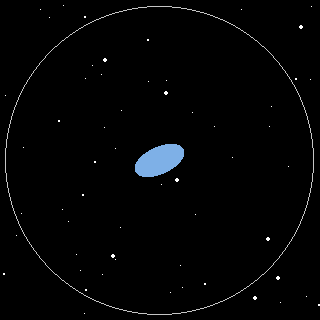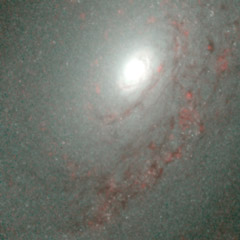| Nearly
Face-on Spiral Galaxy
aka M 64, NGC 4826, PGC 44182, MCG 4-31-1, Uppsala 8062 Integrated Visual Magnitude: 9.3 Apparent Diameter: 10.7' x 5.1' Mean Surface Brightness: 22.3 mag/arc-sec2 Distance: 10-20 million ly |
 It
is a rare treat for a galaxy to reveal some visual detail peculiar only
to itself. What makes M64 both visually interesting and unique is
the large arcing dust cloud near its center. This dark cloud lends
the name "Black Eye Galaxy."
It
is a rare treat for a galaxy to reveal some visual detail peculiar only
to itself. What makes M64 both visually interesting and unique is
the large arcing dust cloud near its center. This dark cloud lends
the name "Black Eye Galaxy."
Discovered by Bode in 1779, M64 is a rather prominent, 9th magnitude, oval visible even in binoculars from a dark site. A 4-inch or larger telescope is usually necessary to make out the famous dark patch, assuming an experienced, dark adapted observer at a dark site.
In a 6-inch scope M64 appears as a smooth white oval. The dark spot should become apparent with a little effort from a dark site. Don't look for something with the stark contrast seen in images, but rather an arc where the white haze is just a bit fainter.
I recently had a look at M64 in my 18-inch f/4.5 and I was struck by something that I haven't seen mentioned elsewhere. The quality of the light from this galaxy appears oddly granular. The galaxy almost sparkles as if made up from myriad tiny specks of light. I noticed this effect on a night when I had the opportunity to observe the Veil nebula later in the evening. The contrast between the light of these two objects was difficult to miss. Compared to M64, the Veil has a very smooth texture, almost like spilt milk. I have no explanation for the granular appearance of M64, although I suspect it has to do more with visual perception than a physical phenomenon.

The view in a 6-inch at 50x. North is down and east is to the right.

| Millennium
Star Atlas Vol II Chart 676
Sky Atlas 2000 Chart 7 Uranometria 2000 Vol I Chart 149 |